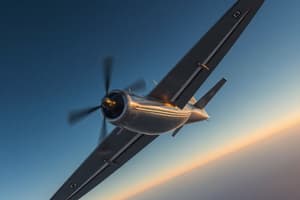Podcast
Questions and Answers
What is the implication of thrust being directed upward during climbs and slow flight?
What is the implication of thrust being directed upward during climbs and slow flight?
- It stabilizes the angle of attack.
- It acts as if it were an additional lift force. (correct)
- It increases drag proportionally.
- It reduces the total weight of the aircraft.
What is the consequence of the aircraft's weight being directed backward in certain conditions?
What is the consequence of the aircraft's weight being directed backward in certain conditions?
- It acts as an additional thrust force.
- It is completely irrelevant to drag.
- It creates a pull backward that affects speed. (correct)
- It modifies the angle of attack instantly.
In steady flight, what must be true about the components of the forces acting on an aircraft?
In steady flight, what must be true about the components of the forces acting on an aircraft?
- All forward forces must exceed backward forces.
- The sum of upward forces equals the sum of downward forces. (correct)
- Thrust and weight act in the same direction.
- All upward forces exceed downward forces.
How is the angle of attack (AOA) defined in aerodynamics?
How is the angle of attack (AOA) defined in aerodynamics?
What is often omitted in discussions of aerodynamic forces in aeronautical texts?
What is often omitted in discussions of aerodynamic forces in aeronautical texts?
What role do thrust and drag play in straight, level, unaccelerated flight?
What role do thrust and drag play in straight, level, unaccelerated flight?
What statement best describes the thrust vector during a glide?
What statement best describes the thrust vector during a glide?
Which of the following statements regarding lift and weight in controlled flight is correct?
Which of the following statements regarding lift and weight in controlled flight is correct?
What is the primary role of thrust in flight?
What is the primary role of thrust in flight?
How does weight affect an aircraft during flight?
How does weight affect an aircraft during flight?
Which force is not present in steady, straight flight?
Which force is not present in steady, straight flight?
What is drag in the context of flight?
What is drag in the context of flight?
What defines the direction of lift during flight?
What defines the direction of lift during flight?
What does Newton's Third Law imply about the forces acting on an aircraft?
What does Newton's Third Law imply about the forces acting on an aircraft?
In what situation do all four forces acting on an aircraft become equal?
In what situation do all four forces acting on an aircraft become equal?
Why is lift crucial for an aircraft to maintain altitude?
Why is lift crucial for an aircraft to maintain altitude?
Flashcards are hidden until you start studying
Study Notes
Forces Acting on Aircraft
- Four primary forces: thrust, drag, lift, and weight, influence aircraft in flight.
- Understanding and controlling these forces is crucial for safe flight maneuvers.
- In straight-and-level, unaccelerated flight, thrust and drag, as well as lift and weight, balance each other.
Definitions of Forces
- Thrust: Generated by the powerplant/propeller or rotor; acts forward and opposes drag.
- Drag: A rearward force caused by airflow disruption; opposes thrust and acts parallel to the relative wind.
- Lift: Created by the dynamic effect of air on the airfoil; acts perpendicular to the flight path, counteracting weight during level flight.
- Weight: Sum of the aircraft, crew, fuel, and cargo; pulls the aircraft down due to gravity and opposes lift vertically through the center of gravity.
Force Relationships
- In steady flight, the sum of forces always equals zero, aligning with Newton's Third Law: every action has an equal and opposite reaction.
- Thrust and drag are equal to each other, while lift and weight are equal in steady, straight flight.
- In level flight, lift and weight are equivalent, but thrust and drag do not equate to these forces.
Flight Conditions
- In climbs and slow flight, thrust can have an upward component, acting similarly to lift.
- During glides, weight can act as thrust by propelling the aircraft forward.
- Flight path deviations require analysis of force vectors, breaking them into components.
Angle of Attack (AOA)
- AOA is the acute angle between the airfoil's chord line and the relative wind direction.
- Understanding AOA is essential for assessing aircraft performance, stability, and control.
- Basic concepts of aerodynamic forces can be simplified without delving into complex specifics.
Practical Application
- Pilots utilize thrust, drag, lift, and weight to achieve controlled and safe flight.
- Recognizing the interaction of forces is vital for efficient performance during various flight conditions.
Studying That Suits You
Use AI to generate personalized quizzes and flashcards to suit your learning preferences.




